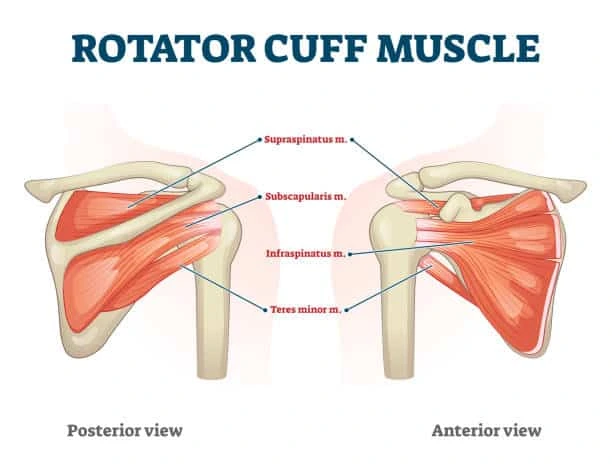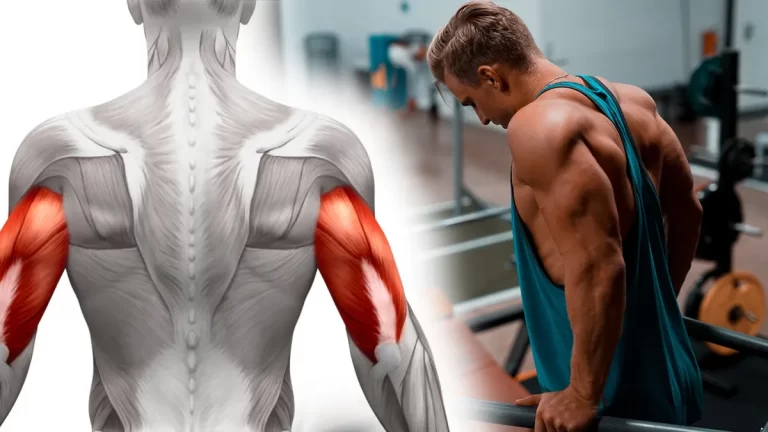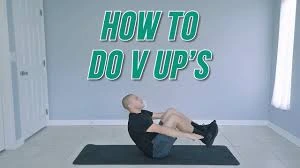Rotator cuff muscle exercise
Table of Contents
Introduction
- The Rotator Cuff muscle exercise helps to increase the strength of the rotator cuff muscle. It helps to maintain function and activities of daily living like pushing and pulling objects. It helps to support healthy cartilage. The Joint cartilage needs motion and a certain amount of stress to stay healthy. It helps to improve the shoulder joint range of motion and its function. Rotator cuff muscle exercise gives stability and it can help you to prevent bone dislocation as well as protect bones from impact and friction, thereby reducing pain
- The Rotator Cuff muscle is a common name for the group of 4 distinct muscles and their tendons, which provide strength and stability during the shoulder complex movement. The Rotator Cuff muscles arise from the scapula and connect to the head of the humerus, forming a cuff around the glenohumeral joint.
- The rotator cuff muscles include 4 muscles:
- Supraspinatus
- Infraspinatus
- Teres minor
- Subscapularis
- Supraspinatus: It is one of the musculotendinous support structures called the rotator cuff that surrounds and encloses the shoulder. It helps to resist the inferior gravitational forces placed across the shoulder joint due to the downward pull of the weight of the upper limb. It Originate frem the Supraspinatus fossa of the scapula. It is Inserted on the Greater tuberosity of the humerus, the superior facet. The nerve supply of the Supraspinatus muscle is the Suprascapular Nerve, C5 & 6, the superior trunk of the brachial plexus. The Blood Supply of the Supraspinatus muscle is the Suprascapular Artery.
- It abducts the arm from 0 to 15 degrees, when it is the main agonist, then assists the deltoid to produce abduction beyond this range up to 90 degrees. It also performed Internal Rotation of the Glenohumeral joint
- Infraspinatus: It is a thick, triangular shape of muscle; one of the four muscles which comprise the Rotator Cuff of the shoulder joints. It originate from the infraspinatus fossa of the scapula. It is inserted on the posterior aspect of the greater tuberosity of the humerus, and the capsule of the shoulder joint. The nerve supply of the Infraspinatus muscle is the Suprascapular Nerve (C5 & C6). The Blood Supply of the Infraspinatus is the Suprascapular and circumflex scapular arteries. the Infraspinatus muscles are the lateral rotator of the shoulder joint. It also assists in producing shoulder extension. With the arm fixed, abduction of the inferior angle of the scapula.
- Teres Minor: Teres Minor is a narrow muscle above the teres major and triceps brachii muscle. Teres Minor lies below the infraspinatus muscles, and deep into the deltoid muscles. It is one of the four muscles which form the Rotator Cuff.
- It originates from the upper two-thirds of the lateral border of the scapula. It is inserted on the Greater tubercle of the humerus. The Nerve Supply of the teres minor is The axillary nerves C5, and C6. The Blood Supply of the teres minor is the circumflex scapular artery and the posterior circumflex humeral artery. It performed External rotation of the shoulder joint.
- It also assists in the adduction and extension of the shoulder joints. During the humerus is stabilized, abduct the inferior angle of the scapula.
- Subscapularis: subscapularis muscle is an originte from the subscapular fossa of the scapula. The “subscapularis” means under the scapula. It is the triangular-shaped largest muscle. In the rotator cuff muscle, the subscapularis muscle is the largest and strongest muscle. the subscapularis muscle is Inserted on the lesser tuberosity of the humerus. The nerve supply of the subscapularis is both the upper and lower subscapular nerves that come from the posterior cord of the brachial plexus. The upper part of the subscapularis supply by the upper subscapular nerve, while the lower subscapular nerve branches into two, with one branch supplying the lower part of the subscapularis. The Blood Supply of the subscapularis muscle is the Subscapular artery. The primary function of the subscapularis muscle is the internal rotation of the shoulder joint. It also helps in shoulder adduction and extension in some positions.
- The rotator cuff muscle includes two types of exercise:
- Active exercise
- Strengthening exercise
- Stretching exercise
Health benefits of Rotator cuff muscle exercises.
- Rotator cuff muscle exercise is designed to build muscle around your shoulder joint.
- Helps to reduce Shoulder pain in the shoulder joint: This exercise will strengthen muscles, and stronger muscles provide your joint with great support. One danger of shoulder arthritis is that every person avoids activities that cause discomfort or pain, causing shoulder muscles to atrophy.
- It helps to maintain function and activities of daily living like pushing and pulling objects.
- It helps to support healthy cartilage. The Joint cartilage needs motion and a certain amount of stress to stay healthy.
- It helps to improve the shoulder joint range of motion and its function.
- Rotator cuff muscle exercise gives stability and it can help you to prevent bone dislocation as well as protect bones from impact and friction, thereby reducing pain
Active exercise
Pendulum swing
- If you have pain in your back, do not do the Pendulum swing exercise.
- Hold on to the table or the back of a chair with your good arm. Then bend forward a little and let your sore arm hang down straight. This exercise doesn’t use the arm muscles. Rather, use your legs and your hips to create the movement that makes your arm swing freely.
- Use the movement from your hips and legs to guide the slightly swinging arm back and forth like the pendulum (or elephant trunk). Then guide it in circles that start from small (about the size of a dinner plate). Make the circles a bit large each day, as your pain allows.
- You can do this exercise for 5 minutes, 5 to 7 times each day.
- As you have less pain, to do this exercise try bending over a little farther. This will increase the amount of movement at your shoulder level.

Shoulder rotation (lying down)
To make a wand for this exercise you can use a piece of PVC pipe or a broom handle with the broom removed. Make the wand about a foot wider than the shoulders.
- Lie on your back. Hold the wand with both hands with your elbows bent and palms up.
- Keep your elbows close to your body, and move the wand across your body toward the affected arm.
- Hold for 8 to 12 seconds.
- Repeat 2 to 4 times.

Wall climbing (to the side)
Avoid any types of movement that is straight to your side, and be careful not to arch your back. Your arm should stay about thirty degrees to the front of your side.
- Stand with your side to a wall so that your fingers can just touch it at an angle of about thirty degrees toward the front of your body.
- Walk the fingers of your affected arm up the wall as high as you can. do not try to shrug your shoulder up toward your ear as you move your arm up.
- Hold the position for a count of at least 15 to 20.
- Walk your fingers back down to the beginning position.
- Repeat at least 2 to 4 times. Try to reach higher each time.
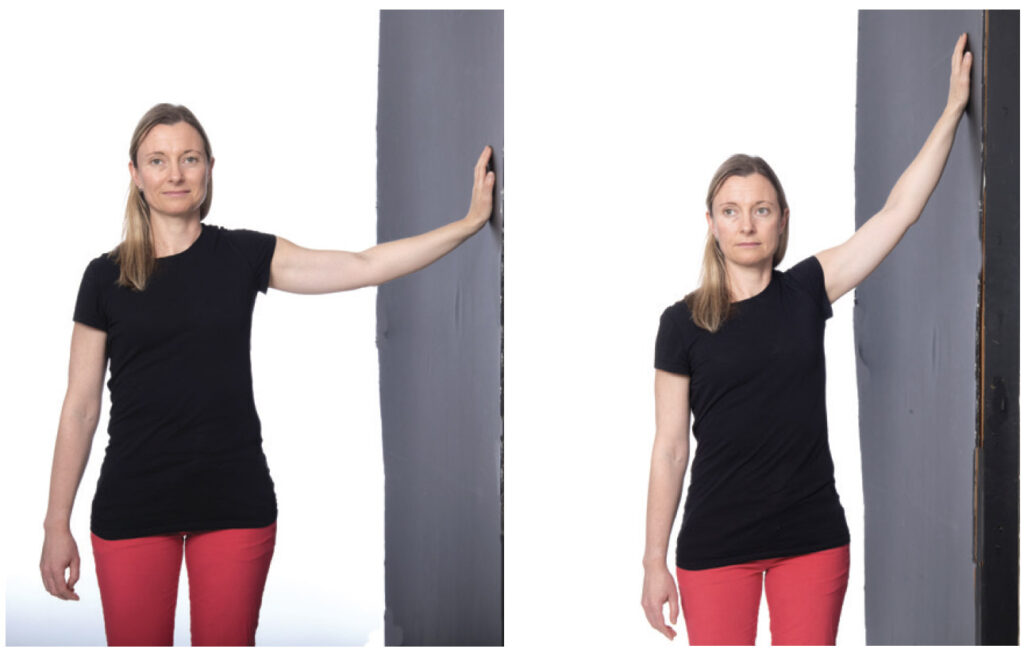
Strengthening exercise
Isometric shoulder rotator cuff exercises
- Isometric exercises are some of the first torn rotator cuff muscle exercises to be done as they do not involve any movement.
- The patient pushes against the stationary object such as a wall, door frame, or resistance provided by another person. Because there is no movement, static exercises can be performed soon after injury, usually within 3 to 7 days, provided they are pain-free.
- If any exercises are painful, then do not continue that exercise. Exercises should be done in the range of different shoulder positions.
- Exercises that involve pressing your arm against the wall can help strengthen the muscles that make up your rotator cuff. With your elbow bent at a 90-degree angle, put the palm of your hand on the side of a wall or door frame that’s in front of you. Place the folded towel between your side and upper arm. Your goal is to keep the towel there as you press your palm against the wall or doorframe for some seconds.
- For the second exercise, keep the towel in place (not shown) and shift your body so that you are standing next to a wall. With your elbow bent at a 90-degree angle, press your elbow and forearm against the wall for some seconds.
- Repeat each exercise 10 times and 5 sets.

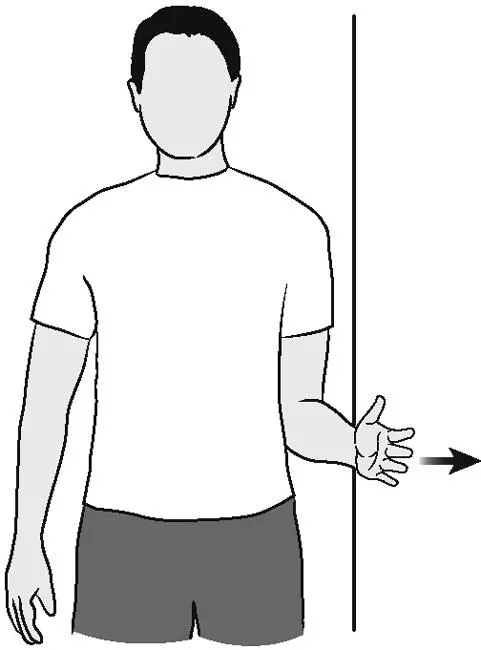
Side-lying external rotation with the dumbbell
- Lie down on the side opposite your affected arm.
- Bend the elbow of your affected arm to 90 degrees and rest the elbow on your side. Your forearm should rest across the abdomen.
- Hold a light dumbbell in the affected side’s hand and, keeping your elbow against your side, slowly raise the dumbbell toward the ceiling. Stop rotating your arm if you feel pain or discomfort.
- Hold the dumbbell up for a few seconds before returning to the initial position with your arm down.
- Repeat 3 sets of 10 repetitions up to 3 times per day. Increase reps to 20 when a set of 10 becomes easy for you.
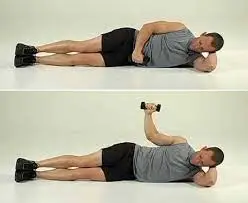
High-to-low rows
Attach a resistance band to something stable at or above shoulder height. Be sure it is secure so it does not come to lose when you pull on it.
Get down on one knee so the knee opposite your affected arm is raised. Your body and the lowered knee should be aligned. Then Rest your other hand on the raised knee.
Hold the band securely with your arm outstretched, and pull your elbow toward your body. your back should be straight and squeeze the shoulder blades together and down as you pull. Your body should not move or twist with the arm.
Return to start and repeat 3 sets of 10 repetitions.
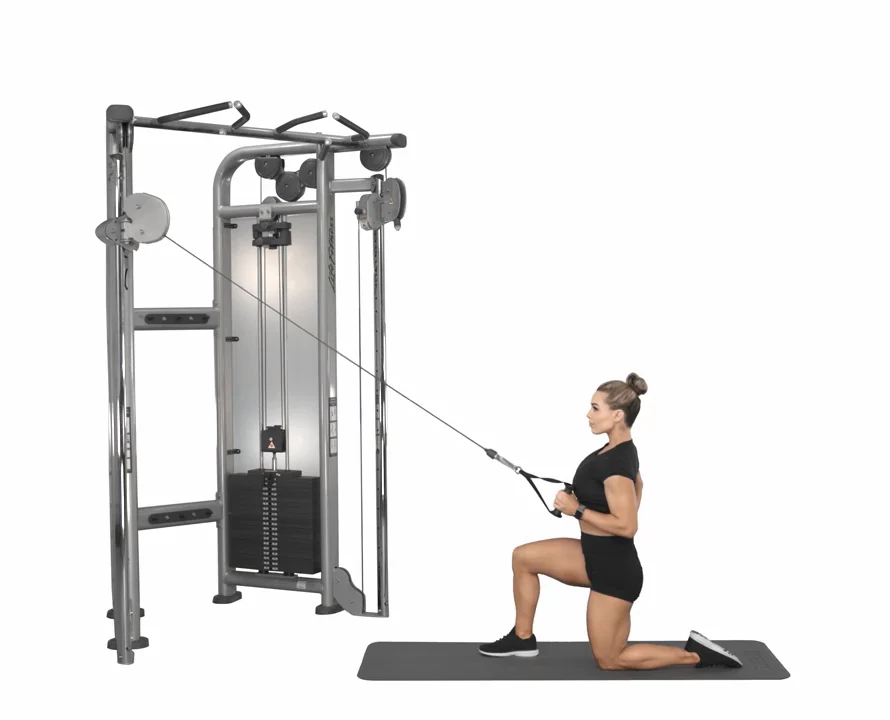
Reverse fly
the patient’s position is to Stand with your feet shoulder-width apart and your knees bent slightly. Keep your back straight and bend forward at the waist slightly.
With the light weight in each hand, extend your arms and raise them away from the body. Do not lock your elbow. then Squeeze your shoulder blades together as you do so. Do not raise your arms above your shoulder height.
Return to start and repeat 3 sets of 10 repetitions.
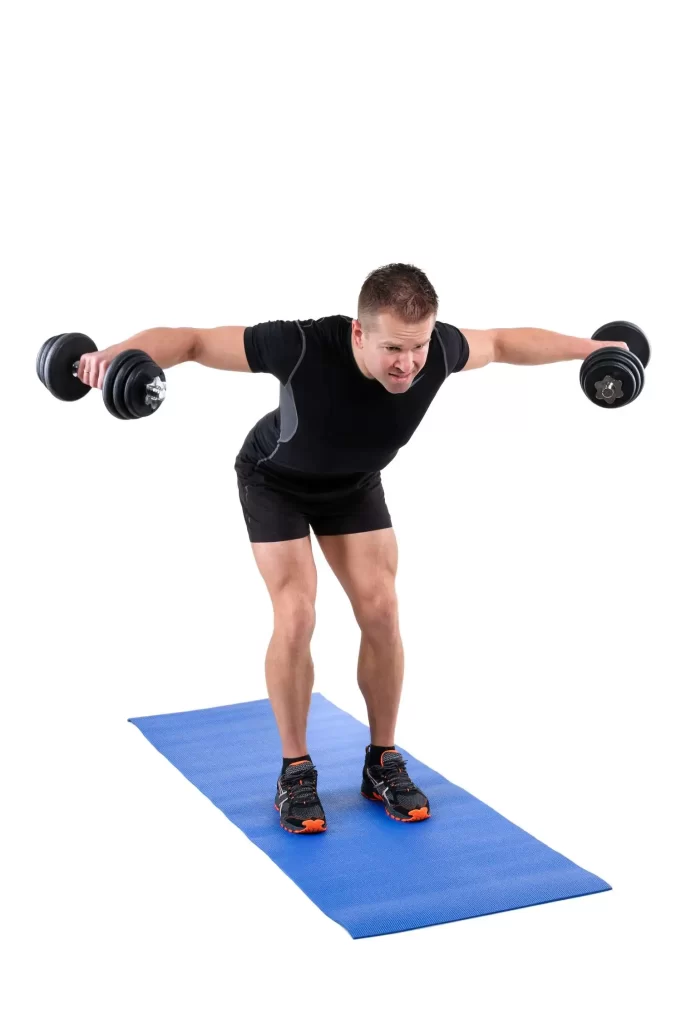
Lawn mower pull
the patient’s position is to stand with your feet shoulder-width apart. Place one end of the resistance band under the foot opposite your affected arm. Hold the other end with the affected arm, so the resistance band goes diagonally across your body.
Keep your other hand on your hip and without locking your knees, bend slightly at the waist so the hand holding the resistance band is parallel to the opposite knee.
As if starting the lawn mower in slow motion, straighten upright while pulling your elbow across the body to your outside ribs. Keep your shoulders relaxed and squeeze the shoulder blades together as you stand.
Repeat 3 sets of 10 repetitions.
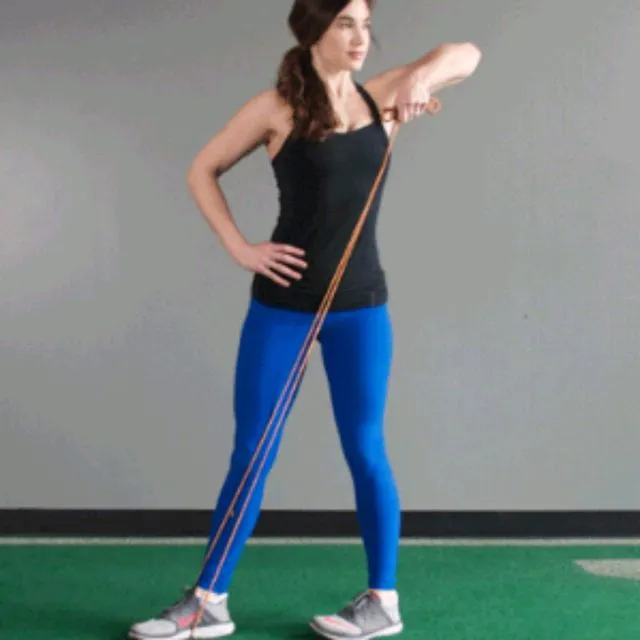
Stretching exercise
Sleeper stretch
Main muscles worked re Infraspinatus, teres minor muscle
You can feel this stretch in your outer upper back, behind your shoulder
Lie on your side on a firm, flat surface with the affected shoulder under you and your arms flexed. You can place your head on the pillow for comfort if needed.
Use your unaffected arm to push your other arm downwards. Stop pressing down when you feel the stretch in the back of your affected shoulder.
You can hold this position for 30 seconds, then relax your arm for 30 seconds.
Tip: Do not bend your wrist or press down on the wrist.
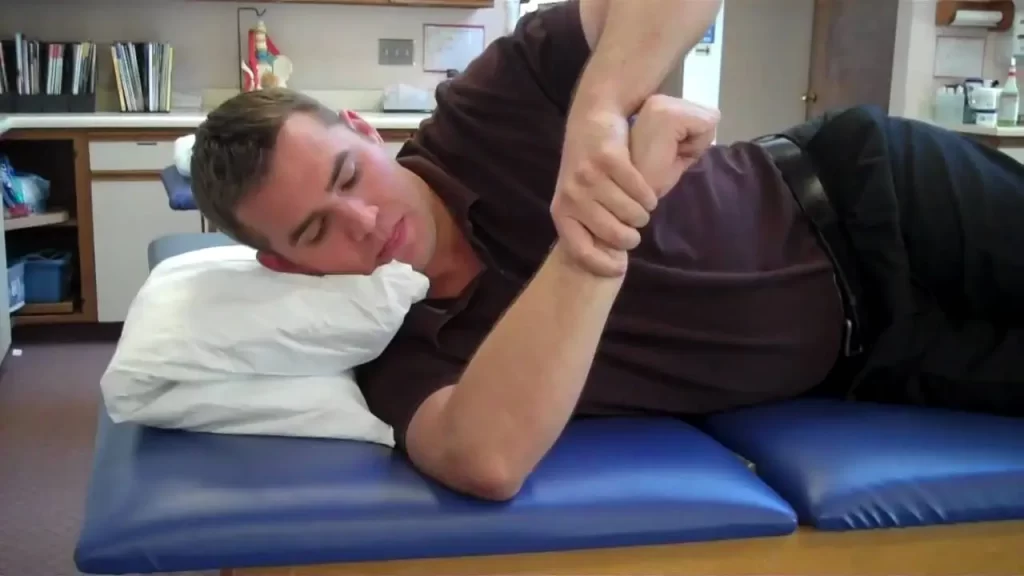
Posterior stretching exercise
Hold the elbow of your injured arm with the other hand.
Use your hand to pull your injured arm up gently and across your body. You can feel a gentle stretch across the back of your injured shoulder.
You can hold for at least 15 to 30 seconds. Then slowly lower your arm.
Repeat 2 to 4 times.
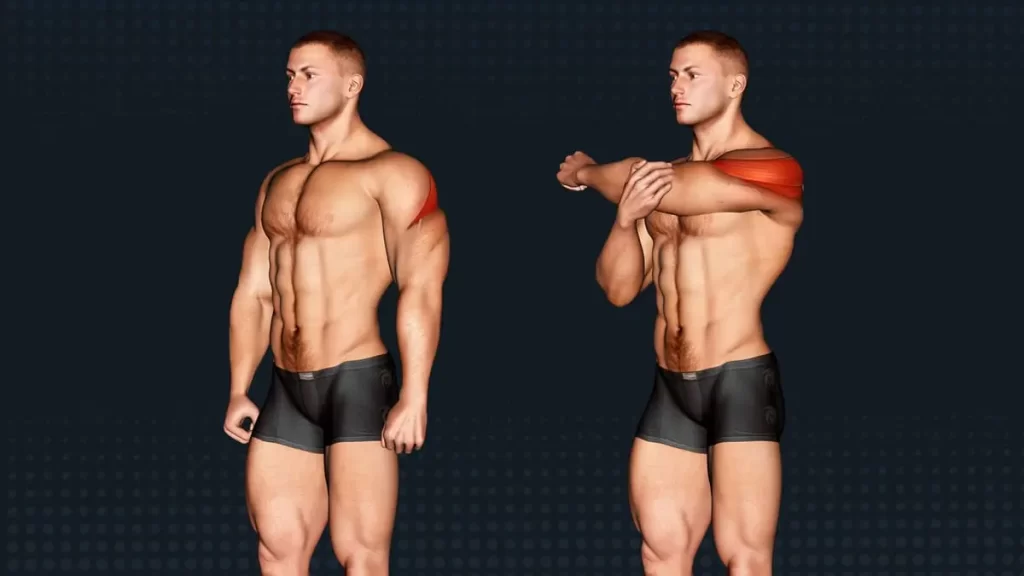
Up-the-back stretch
Your doctor or physical therapist may want you to wait to do this stretching until you have regained most of your range of motion and strength. You can do this stretching in different ways. Hold any of these stretches for 15 to 30 seconds. Repeat them 2 to 4 times.
Light stretch: In this exercise Put your hand in your back pocket. Let it rest there to stretch the shoulder.

Moderate stretch: With your other hand, hold your affected arm (palm outward) behind your back by the wrist. Pull your arm gently up to stretch your shoulder.
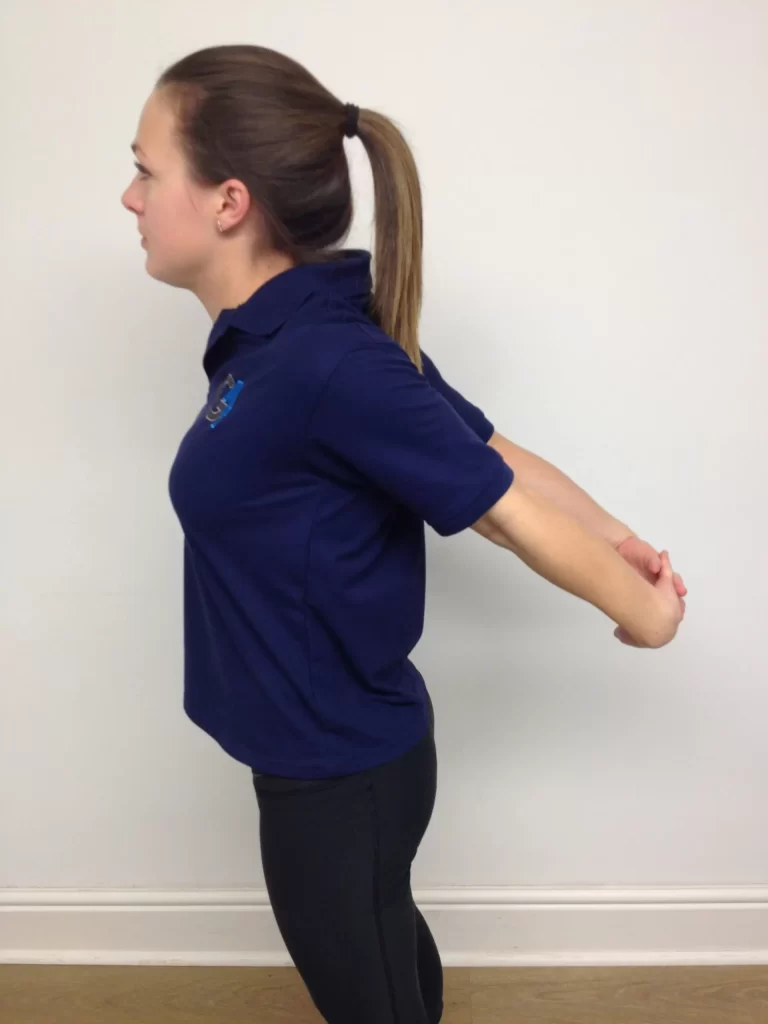
Advanced stretch: Put a towel on your other shoulder. Put the hand of your affected arm behind your back. Then holds the back end of the towel. With the other hand, hold the front end of the towel in front of the body. Pull on the front end of the towel gently. This will bring your hand farther up your back to stretch the shoulder.
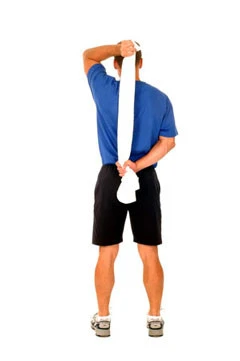
Overhead stretch
Standing about an arm’s length away, grasp onto the solid surface. You can use a countertop, a doorknob, or the back of a sturdy chair.
With your knees slightly bent, bend forward with your straight arms. Lower your upper body, and let’s stretch your shoulders.
As your shoulders are able to stretch farther, you may need to take a step or two back.
You can hold it for 15 to 30 seconds. Then stand up and relax. If you had stepped back during your stretch, step forward so you can keep your hands on the solid surface back.
Repeat 2 to 4 times.
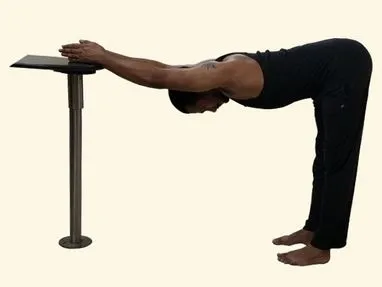
Doorway stretch
First Warm up your muscles by standing in an open doorway and spreading your arms out to the side.
Then Grip the sides of the doorway with each hand at or below shoulder height, and lean forward through the doorway until you can feel a light stretch.
Keep the back straight as you lean and shift your weight onto your toes. You can feel a stretch in the front of your shoulder. Do not overstretch.
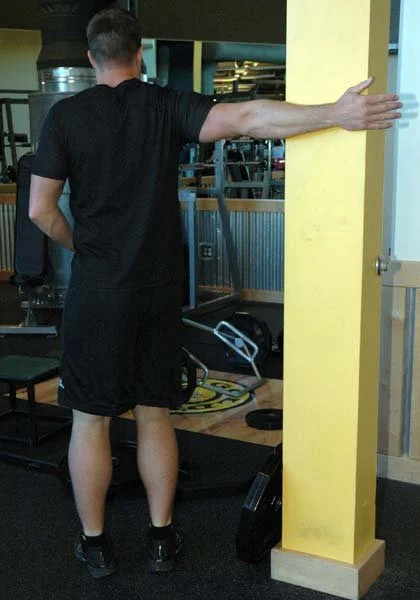
Crossover arm stretch
The crossover arm stretch involves the below steps:
Lift one arm so that it is perpendicular to the ground and extend it straight without locking it.
Take the wrist of the extended, lifted arm with the opposite side hand.
Gently pull the arm across the front of your body, trying to hug the chest with the arm.
You can hold the stretch for 5 seconds before slowly releasing it.
Repeat on the other side.

Two-arm wall stretch
People can perform this stretch by doing the following steps:
The patient’s position is to Stand up straight with the back against the wall.
Raise each arm sideways into an L-shape with the upper arms parallel to the ground keeping the arms as flat against the wall as possible.
Maintaining the bent elbow, move the arms up the wall to bring the hands closer together, and then move them back down.
Return to the resting position.
Safety and Precautions during Rotator Cuff muscles exercise
- Throwing a ball in an overhead fashion, particularly the heavy balls.
- Avoid swimming, in particular, the strokes that involve an overhand movement.
- Lifting weights that place stress on the shoulder and rotator cuff muscles.
- Do not bounce. Ballistic stretching is dangerous, so avoid bouncing while doing stretches unless suggested by your physiotherapist.
- Go gently. Mostly, stretches are slow and gentle, so do not race to complete the stretch.
- If you have a prior injury, such as an acute or chronic one, you try stretching after your physiotherapist’s suggestion.
When do not do the Rotator Cuff muscles strengthening exercise?
- When your shoulder joint is recently injured.
- When the arm bone is recently fractured.
- When you have severe pain in your joint.
- When your doctor advised you to take rest.
- Stop immediately when you feel any pain or discomfort during these exercises and consult your physical therapist or doctor.
Rotator cuff strengthening exercises
Isometric shoulder rotator cuff exercises
Isometric exercises are some of the first torn rotator cuff muscle exercises to be done as they do not involve any movement. The patient pushes against the stationary object such as a wall, door frame, or resistance provided by another person. Because there is no movement, static exercises can be performed soon after injury, usually within 3 to 7 days, provided they are pain-free. If any exercises are painful, then do not continue that exercise. Exercises should be done in the range of different shoulder positions.
Exercises that involve pressing your arm against the wall can help strengthen the muscles that make up your rotator cuff. With your elbow bent at a 90-degree angle, put the palm of your hand on the side of a wall or door frame that’s in front of you. Place the folded towel between your side and upper arm. Your goal is to keep the towel there as you press your palm against the wall or doorframe for some seconds. For the second exercise, keep the towel in place (not shown) and shift your body so that you are standing next to a wall. With your elbow bent at a 90-degree angle, press your elbow and forearm against the wall for some seconds. Repeat each exercise 10 times and 5 sets.
Reverse fly
the patient’s position is to Stand with your feet shoulder-width apart and your knees bent slightly. Keep your back straight and bend forward at the waist slightly. With the light weight in each hand, extend your arms and raise them away from the body. Do not lock your elbow. then Squeeze your shoulder blades together as you do so. Do not raise your arms above your shoulder height. Return to start and repeat 3 sets of 10 repetitions.
Rotator cuff rehab exercises
Pendulum swing exercise
If you have pain in your back, do not do the Pendulum swing exercise. Hold on to the table or the back of a chair with your good arm. Then bend forward a little and let your sore arm hang down straight. This exercise doesn’t use the arm muscles. Rather, use your legs and your hips to create the movement that makes your arm swing freely. Use the movement from your hips and legs to guide the slightly swinging arm back and forth like the pendulum (or elephant trunk). Then guide it in circles that start from small (about the size of a dinner plate). Make the circles a bit large each day, as your pain allows.
You can do this exercise for 5 minutes, 5 to 7 times each day. As you have less pain, to do this exercise try bending over a little farther. This will increase the amount of movement at your shoulder level.
Shoulder rotation (lying down)
To make a wand for this exercise you can use a piece of PVC pipe or a broom handle with the broom removed. Make the wand about a foot wider than the shoulders. Lie on your back. Hold the wand with both hands with your elbows bent and palms up. Keep your elbows close to your body, and move the wand across your body toward the affected arm. Hold for 8 to 12 seconds. Repeat 2 to 4 times.
What is the best exercise for rotator cuff injury?
Isometric exercises are some of the first torn rotator cuff muscle exercises to be done as they do not involve any movement. The patient pushes against the stationary object such as a wall, door frame, or resistance provided by another person. Because there is no movement, static exercises can be performed soon after injury, usually within 3 to 7 days, provided they are pain-free. If any exercises are painful, then do not continue that exercise. Exercises should be done in the range of different shoulder positions.
Exercises that involve pressing your arm against the wall can help strengthen the muscles that make up your rotator cuff. With your elbow bent at a 90-degree angle, put the palm of your hand on the side of a wall or door frame that’s in front of you. Place the folded towel between your side and upper arm. Your goal is to keep the towel there as you press your palm against the wall or doorframe for some seconds. For the second exercise, keep the towel in place (not shown) and shift your body so that you are standing next to a wall. With your elbow bent at a 90-degree angle, press your elbow and forearm against the wall for some seconds. Repeat each exercise 10 times and 5 sets.
Rotator cuff injury exercises to avoid
Deadlifts: These heavyweight exercises are basically pulling your arm out of your socket.
Shrugs: Another example of weight pulling down on the shoulder.
Squatting: Resting the bar across your shoulders and your arm positioning stresses the rotator cuff muscle.
Exercises for torn rotator cuff without surgery
Pendulum swing exercise
If you have pain in your back, do not do the Pendulum swing exercise.
Hold on to the table or the back of a chair with your good arm. Then bend forward a little and let your sore arm hang down straight. This exercise doesn’t use the arm muscles. Rather, use your legs and your hips to create the movement that makes your arm swing freely. Use the movement from your hips and legs to guide the slightly swinging arm back and forth like the pendulum (or elephant trunk). Then guide it in circles that start from small (about the size of a dinner plate). Make the circles a bit large each day, as your pain allows. You can do this exercise for 5 minutes, 5 to 7 times each day. As you have less pain, to do this exercise try bending over a little farther. This will increase the amount of movement at your shoulder level.
FAQ
Doorway stretch: First Warm up your muscles by standing in an open doorway and spreading your arms out to the side. Then Grip the sides of the doorway with each hand at or below shoulder height, and lean forward through the doorway until you can feel a light stretch. Keep the back straight as you lean and shift your weight onto your toes. You can feel a stretch in the front of your shoulder. Do not overstretch. Isometric exercises are some of the first torn rotator cuff muscle exercises to be done as they do not involve any movement. The patient pushes against the stationary object such as a wall, door frame, or resistance provided by another person. Because there is no movement, static exercises can be performed soon after injury, usually within 3 to 7 days, provided they are pain-free. If any exercises are painful, then do not continue that exercise. Exercises should be done in the range of different shoulder positions. Exercises that involve pressing your arm against the wall can help strengthen the muscles that make up your rotator cuff. With your elbow bent at a 90-degree angle, put the palm of your hand on the side of a wall or door frame that’s in front of you. Place the folded towel between your side and upper arm. Your goal is to keep the towel there as you press your palm against the wall or doorframe for some seconds. For the second exercise, keep the towel in place (not shown) and shift your body so that you are standing next to a wall. With your elbow bent at a 90-degree angle, press your elbow and forearm against the wall for some seconds. Repeat each exercise 10 times and 5 sets.
You might experience some mild soreness with muscle-toning exercises, ice applied to the shoulder should help to relieve it but if you develop sharp or severe pain, stop the exercises for a few days. Sit or stand holding a 5 to 10-pound weight in the hand of the affected shoulder.
For many people, physical therapy is the answer. It may be all you need to treat an injured rotator cuff muscle. physical therapy is a way to get back strength and movement after an injury. It includes things like exercise, ice, heat, massage, and equipment to help return your shoulder back to its normal range of motion(ROM).
Some of the exercises that people should stay away from which include, Throwing a ball in an overhead fashion, particularly heavy balls. Avoid swimming, in particular, the strokes that involve an overhand movement. Lifting weights that place stress on the shoulder and rotator cuff muscle.
Deadlifts: These heavyweight exercises are basically pulling your arm out of your socket. Shrugs: Another example of weight pulling down on the shoulder.
Squatting: Resting the bar across your shoulders and your arm positioning stresses the rotator cuff muscle.
Pendulum swing exercise: If you have pain in your back, do not do the Pendulum swing exercise. Hold on to the table or the back of a chair with your good arm. Then bend forward a little and let your sore arm hang down straight. This exercise doesn’t use the arm muscles. Rather, use your legs and your hips to create the movement that makes your arm swing freely. Use the movement from your hips and legs to guide the slightly swinging arm back and forth like the pendulum (or elephant trunk). Then guide it in circles that start from small (about the size of a dinner plate). Make the circles a bit large each day, as your pain allows. You can do this exercise for 5 minutes, 5 to 7 times each day. As you have less pain, to do this exercise try bending over a little farther. This will increase the amount of movement at your shoulder level. The second exercise you can do t home is Shoulder rotation (lying down).To make a wand for this exercise you can use a piece of PVC pipe or a broom handle with the broom removed. Make the wand about a foot wider than the shoulders. Lie on your back. Hold the wand with both hands with your elbows bent and palms up. Keep your elbows close to your body, and move the wand across your body toward the affected arm. Hold for 8 to 12 seconds.
Repeat 2 to 4 times.

